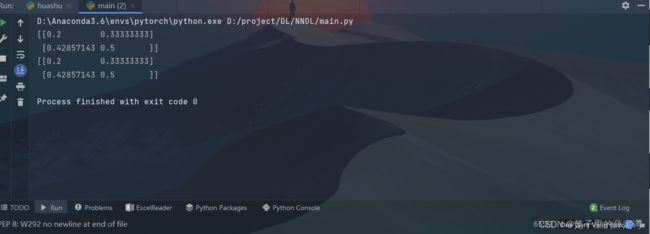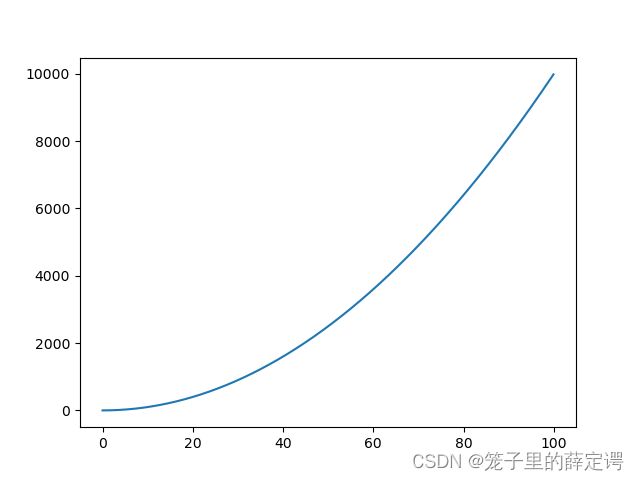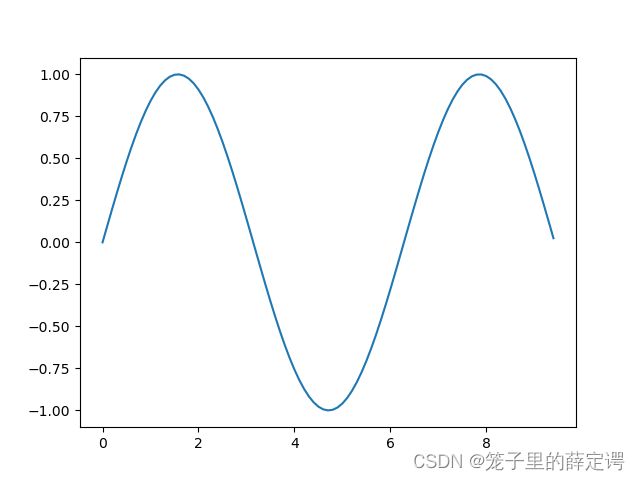NNDL 实验一 numpy
头一次写博客,真的是很潦草了,字体大小颜色、排版都还不太懂
numpy 的array操作
1.导入numpy库
import numpy as np
2.建立一个一维数组 a 初始化为[4,5,6]
(1)输出a 的类型(type)
(2)输出a的各维度的大小(shape)
(3)输出 a的第一个元素(值为4)
a = np.array([4, 5, 6])
print(a.dtype)
print(a.shape)
print(a[0])
3.建立一个二维数组 b,初始化为 [ [4, 5, 6],[1, 2, 3]]
(1)输出各维度的大小(shape)
(2)输出 b(0,0),b(0,1),b(1,1) 这三个元素(对应值分别为4,5,2)
b = np.array( [[4, 5, 6],
[1, 2, 3]] )
print(b.shape)
print(b[0,0],b[0,1],b[1,1])
4.题目如下
(1)建立一个全0矩阵 a, 大小为 3x3; 类型为整型(提示: dtype = int)
(2)建立一个全1矩阵b,大小为4x5
(3)建立一个单位矩阵c ,大小为4x4
(4)生成一个随机数矩阵d,大小为 3x2.
a = np.zeros( (3, 3), dtype = int )
b = np.ones( (4, 5), dtype = int )
c = np.identity( (4), dtype = int )
d = np.random.randint( 1, 10, dtype = int, size = (3, 2) )
print(a)
print(b)
print(c)
print(d)
5.建立一个数组 a,(值为[[1, 2, 3, 4], [5, 6, 7, 8], [9, 10, 11, 12]] )
(1)打印a; (2)输出 下标为(2,3),(0,0) 这两个数组元素的值
a = np.array( [[1, 2, 3, 4],
[5, 6, 7, 8],
[9, 10, 11, 12]] )
print(a)
print(a[2, 3], a[0, 0])
6.把上一题的 a数组的 0到1行 2到3列,放到b里面去
(1)输出b
(2)输出b 的(0,0)这个元素的值
b = a[0:2, 1:3]
print(b)
print(b[0, 0])
7.把第5题中数组a的最后两行所有元素放到 c中(提示: a[1:2, :])
(1)输出 c
(2)输出 c 中第一行的最后一个元素(提示使用 -1 表示最后一个元素)
c = a[1:]
print(c)
print(c[-1][-1])
8.题目如下
建立数组a,初始化a为[[1, 2], [3, 4], [5, 6]],输出 (0,0)(1,1)(2,0)这三个元素(提示: 使用 print(a[[0, 1, 2], [0, 1, 0]]) )
a=np.array([[1, 2],
[3, 4],
[5, 6]])
print(a[[0, 1, 2], [0, 1, 0]])
9.建立矩阵a ,初始化为[[1, 2, 3], [4, 5, 6], [7, 8, 9], [10, 11, 12]],输出(0,0),(1,2),(2,0),(3,1)
a = np.array([[1, 2, 3],
[4, 5, 6],
[7, 8, 9],
[10, 11, 12]])
b = np.array([0, 2, 0, 1])
print(a[np.arange(4), b])
10.对9 中输出的那四个元素,每个都加上10,然后重新输出矩阵a.
a[np.arange(4),b] += 10
print(a)
array 的数学运算
11. 执行 x = np.array([1, 2]),然后输出 x 的数据类型
x = np.array([1, 2])
print(x.dtype)
12.执行 x = np.array([1.0, 2.0]) ,然后输出 x 的数据类类型
x = np.array([1.0, 2.0])
print(x.dtype)
13.执行 x = np.array([[1, 2], [3, 4]], dtype=np.float64) ,y = np.array([[5, 6], [7, 8]], dtype=np.float64),然后输出 x+y ,和 np.add(x,y)
x = np.array([[1, 2],
[3, 4]], dtype = np.float64)
y = np.array([[5, 6],
[7, 8]], dtype = np.float64)
print(x + y)
print(np.add(x, y))
14. 利用 13题目中的x,y 输出 x-y 和 np.subtract(x,y)
print(x - y)
print(np.subtract(x, y))
15. 利用13题目中的x,y 输出 x*y ,和 np.multiply(x, y) 还有 np.dot(x,y),比较差异。然后自己换一个不是方阵的试试。
print(x * y)
print(np.multiply(x, y))
print(np.dot(x, y))
x = np.array([[1, 2, 3],
[4, 5, 6]], dtype = np.float64)
y = np.array([[5, 6, 7],
[7, 8, 9]], dtype = np.float64)
print(x * y)
print(np.multiply(x, y))
print(np.dot(x, y))
输出结果如下:
 报错原因:np.dot()方法是矩阵乘法,需要满足第一个矩阵的列数=第二个矩阵的行数的条件
报错原因:np.dot()方法是矩阵乘法,需要满足第一个矩阵的列数=第二个矩阵的行数的条件
16. 利用13题目中的x,y,输出 x / y .(提示 : 使用函数 np.divide())
print(x / y)
print(np.divide(x, y)) #这两个方法都是对应位置元素做除法
17. 利用13题目中的x,输出 x的 开方。(提示: 使用函数 np.sqrt() )
print( np.sqrt(x) )
18.利用13题目中的x,y ,执行 print(x.dot(y)) 和 print(np.dot(x,y))
print( x.dot(y) )
print( np.dot(x,y) ) #矩阵乘法的两个写法
19.利用13题目中的 x,进行求和。
(1)print(np.sum(x)):
(2)print(np.sum(x,axis =0 ))
(3)print(np.sum(x,axis = 1))
print( np.sum(x) )
print( np.sum(x, axis =0)) #按列求和
print( np.sum(x, axis =1)) #按行求和
20.利用13题目中的 x,进行求平均数
(1)print(np.mean(x))
(2)print(np.mean(x,axis = 0))
(3) print(np.mean(x,axis =1)))
print( np.mean(x) )
print( np.mean(x,axis = 0) ) #按列求平均数
print( np.mean(x,axis = 1) ) #按行求平均数
21.利用13题目中的x,对x 进行矩阵转置,然后输出转置后的结果,(提示: x.T 表示对 x 的转置)
x = x.T
print(x) #矩阵转置写法
22.利用13题目中的x,求e的指数(提示: 函数 np.exp())
print( np.exp(x) )
23.利用13题目中的 x,求值最大的下标
(1).print(np.argmax(x))
(2).print(np.argmax(x, axis =0))
(3).print(np.argmax(x),axis =1))
print(np.argmax(x)) # 元素最大值的索引值
print(np.argmax(x,axis=0)) # 对数组按列方向搜索最大值
print(np.argmax(x,axis=1)) # 对数组按行方向搜索最大值
24,画图,y=x*x 其中 x = np.arange(0, 100, 0.1) (提示这里用到 matplotlib.pyplot 库)
import matplotlib.pyplot as plt
x = np.arange(0, 100, 0.1)
y = x * x
plt.plot(x, y)
plt.show()
25.画图。画正弦函数和余弦函数, x = np.arange(0, 3 * np.pi, 0.1)(提示:这里用到 np.sin() np.cos() 函数和 matplotlib.pyplot 库)
x = np.arange(0, 3*np.pi, 0.1)
y = np.sin(x)
plt.plot(x, y)
plt.show()
y = np.cos(x)
plt.plot(x, y)
plt.show()
新学期要开始系统学习深度学习了,之前都是走马观花式炼丹,对底层原理不清楚,用到什么查什么

所以立个flag:把课本上的前馈神经网络、卷积神经网络、循环神经网络跟着老师搞懂,经典模型搭一搭,把上个学期落下的YOLO理论部分补一补,然后就是多读一些论文,也要在CSDN上多输出一些自己的理解。























